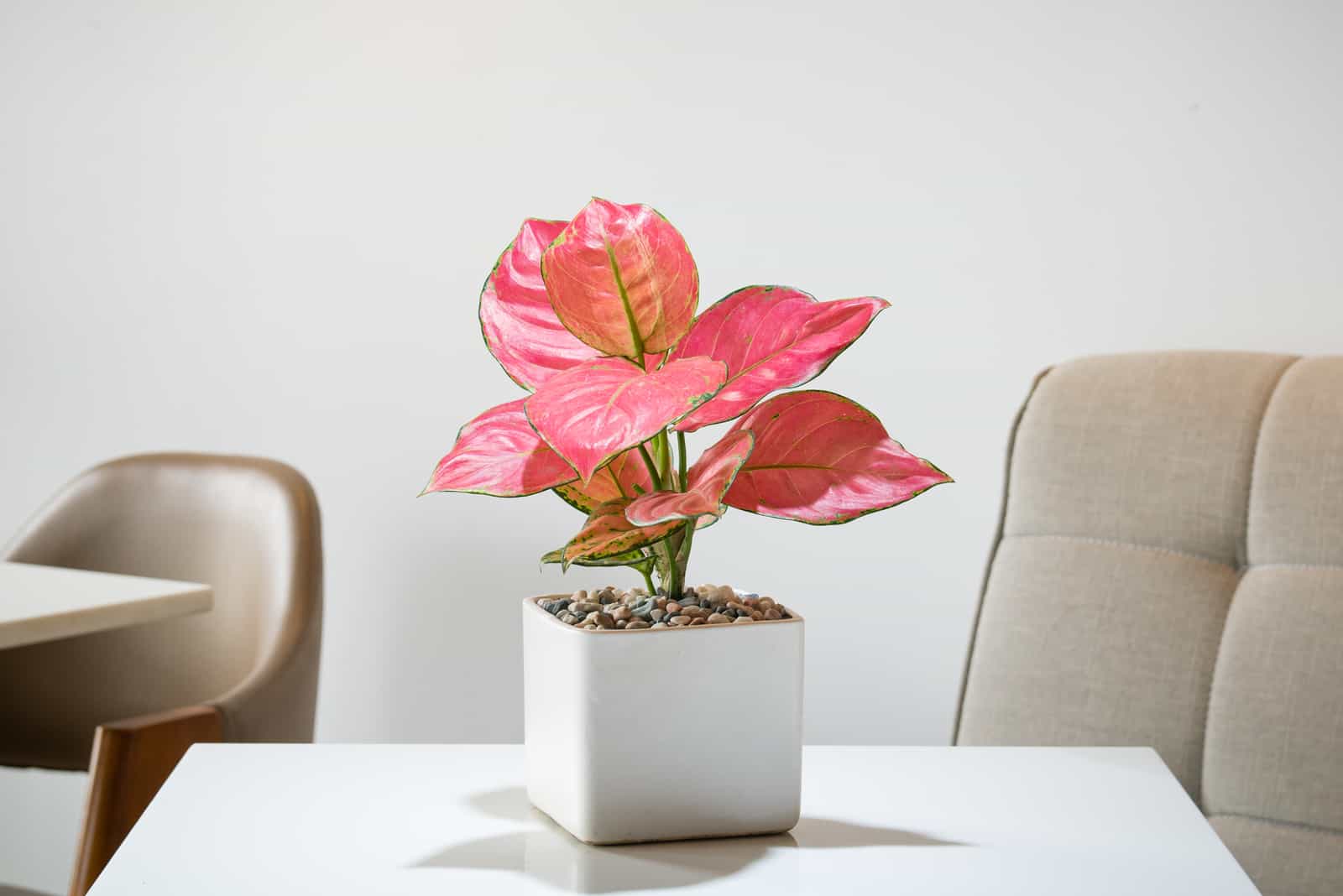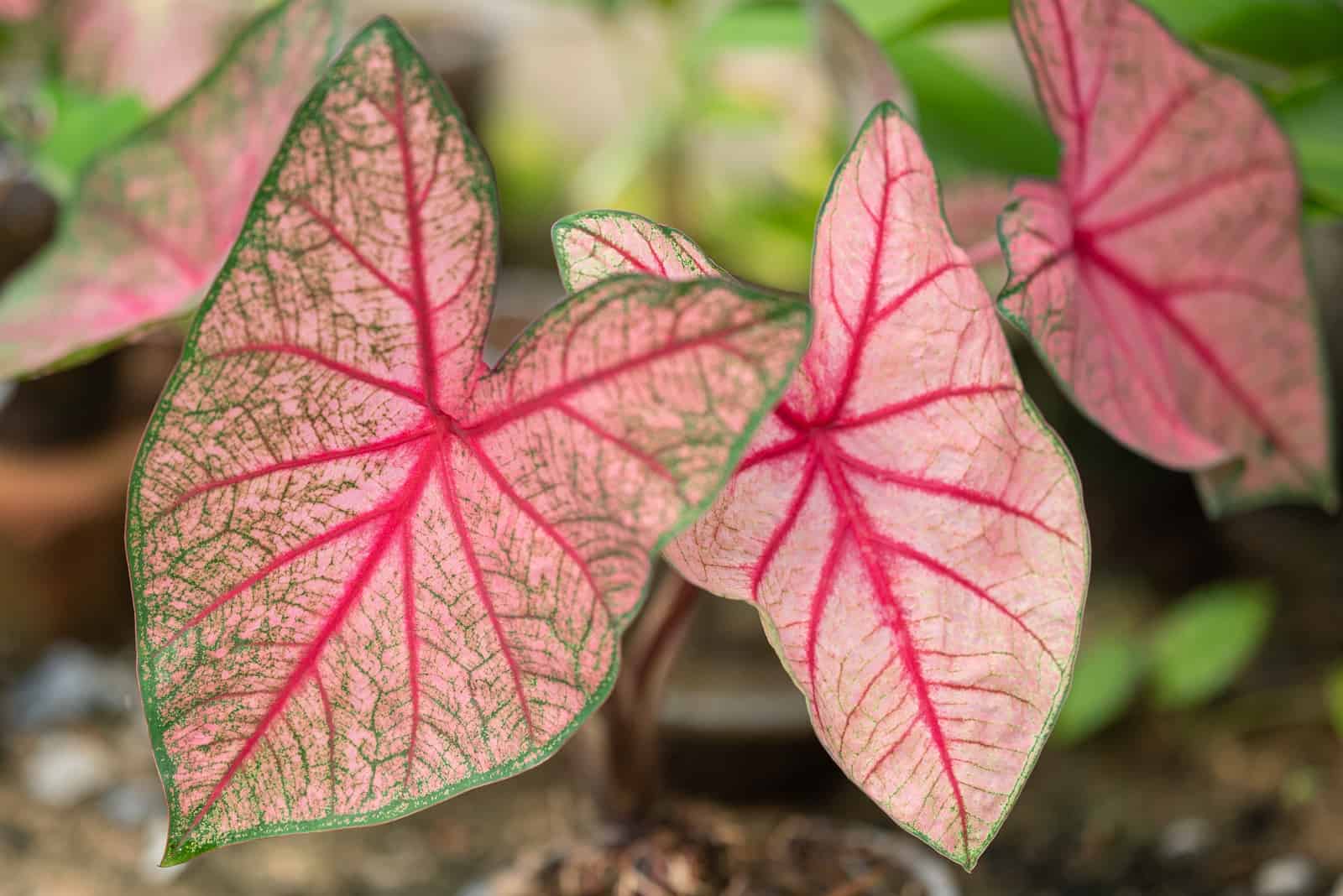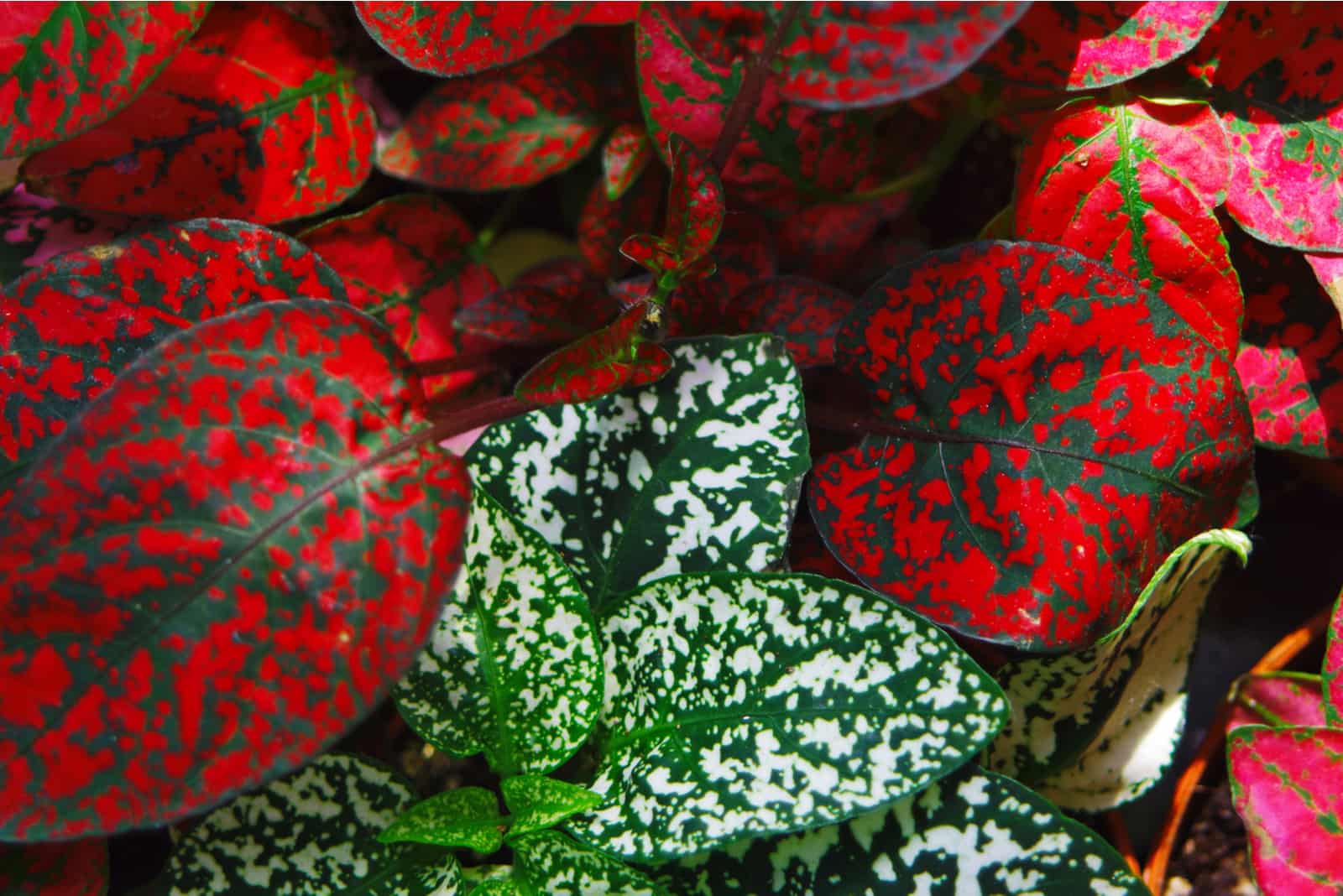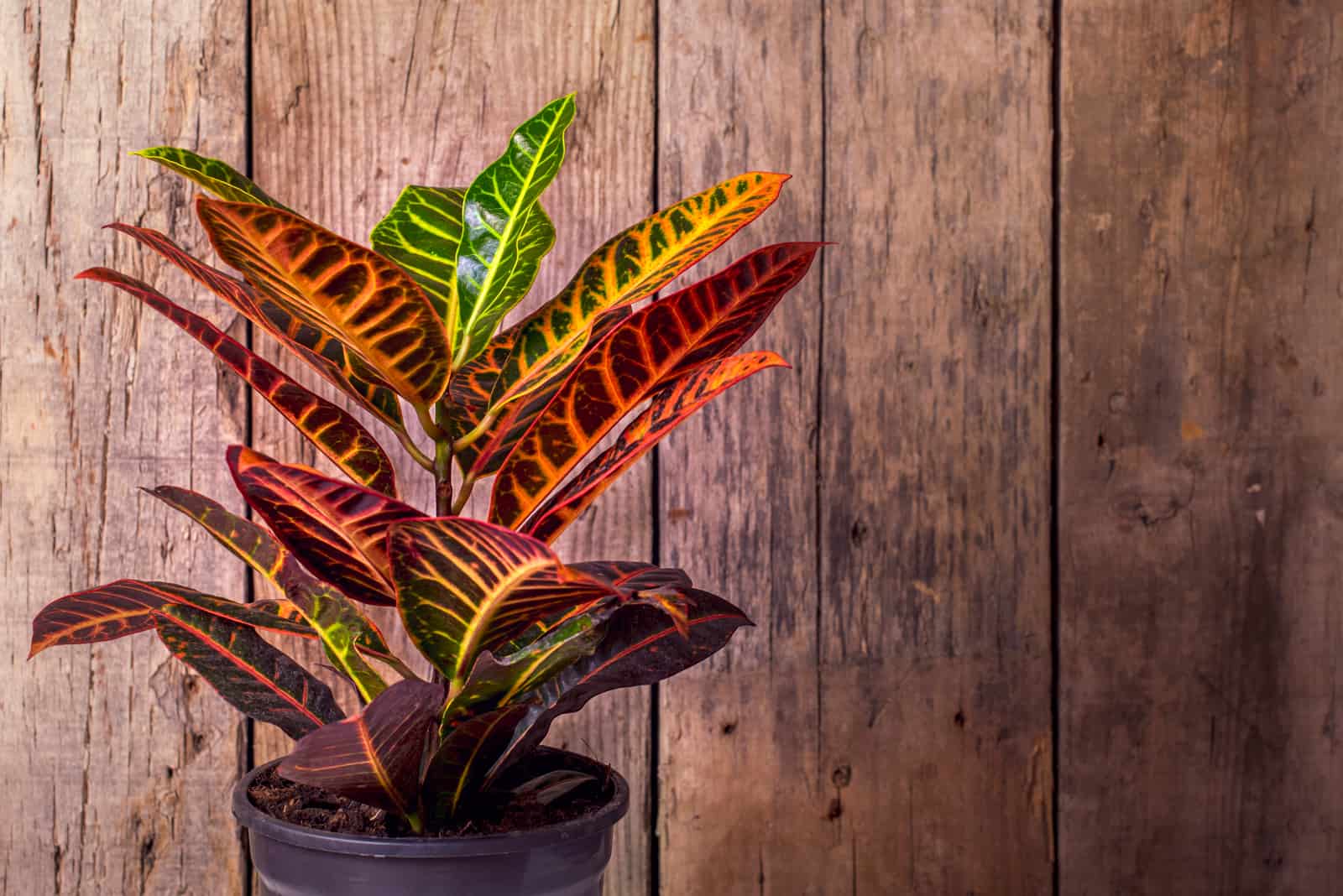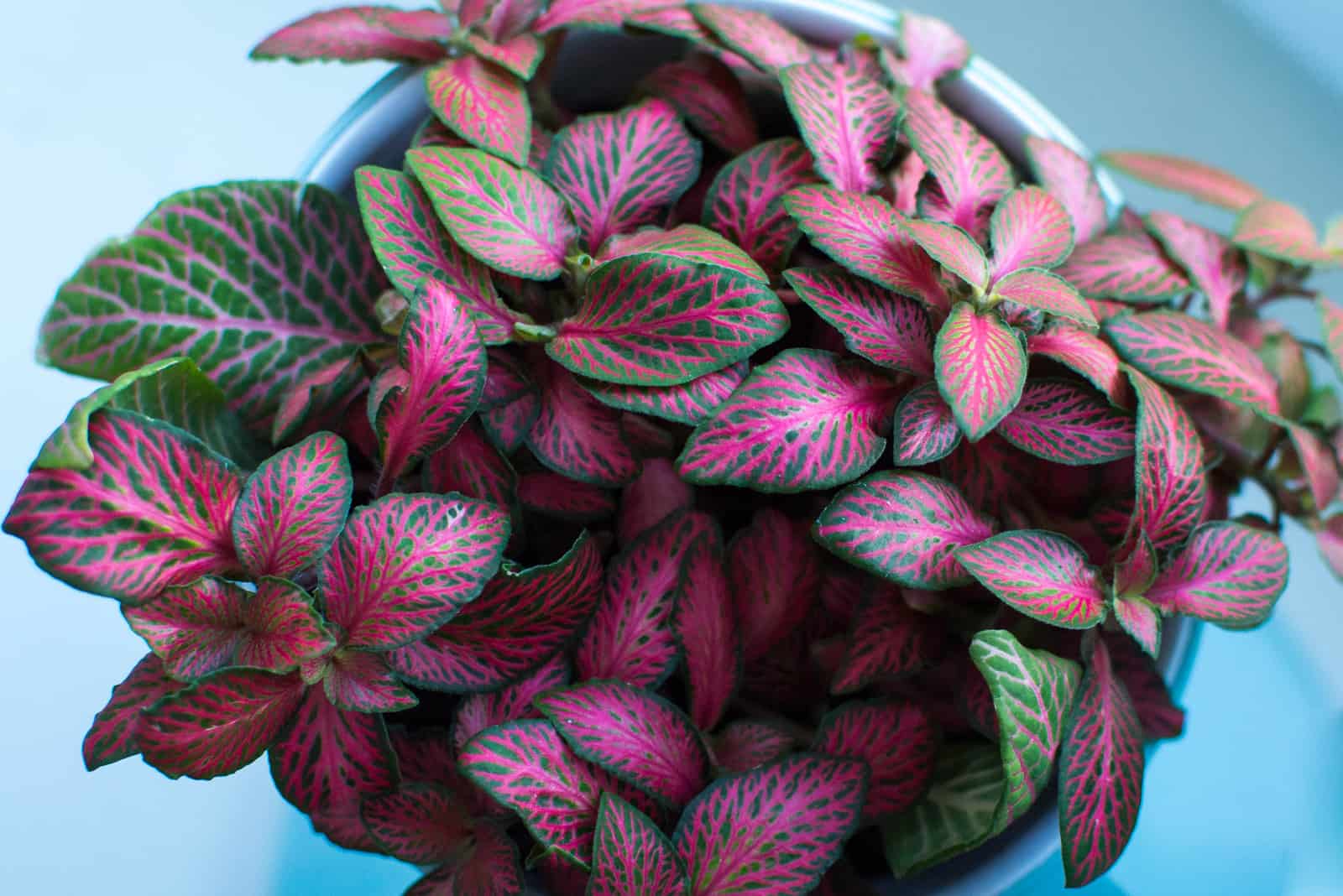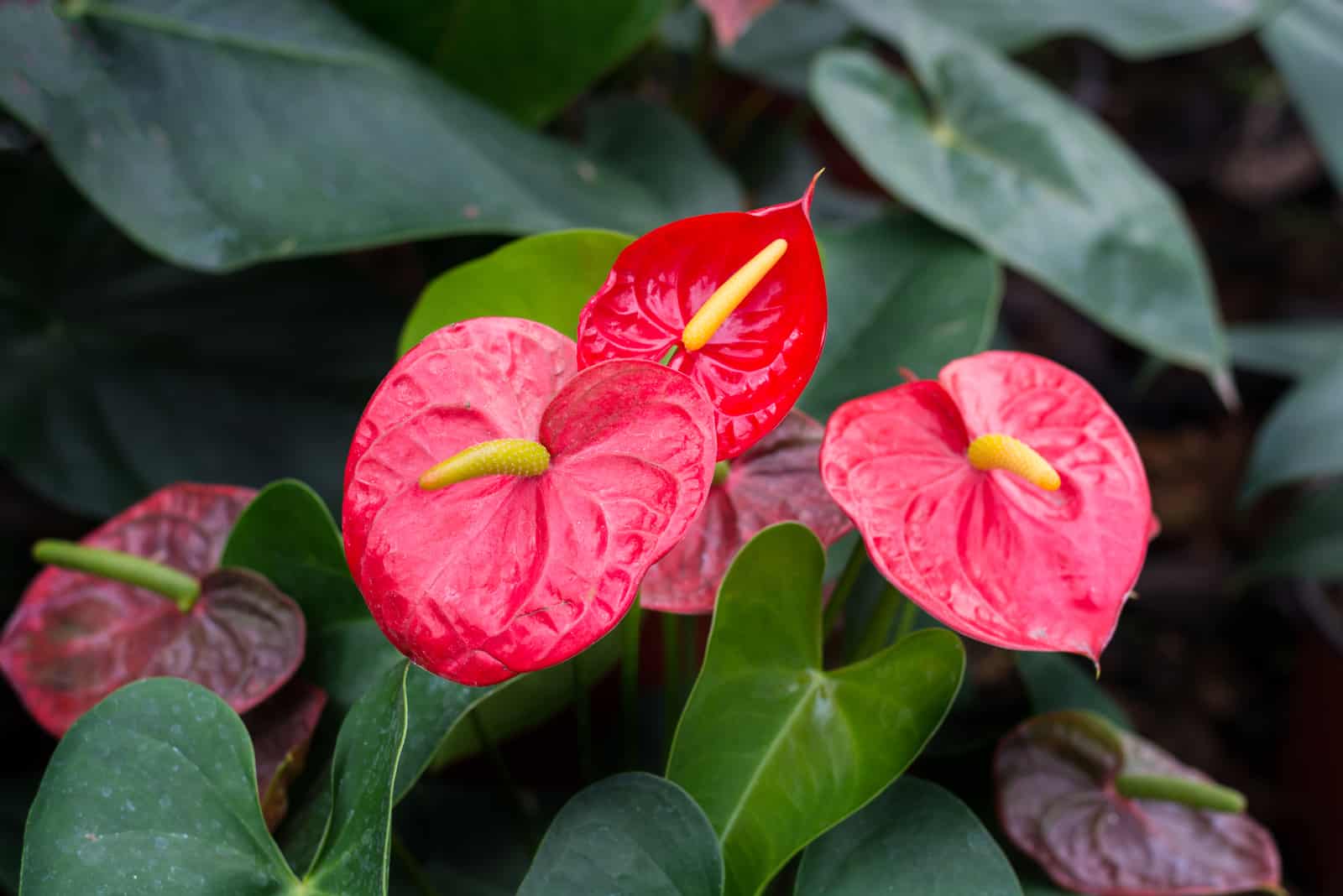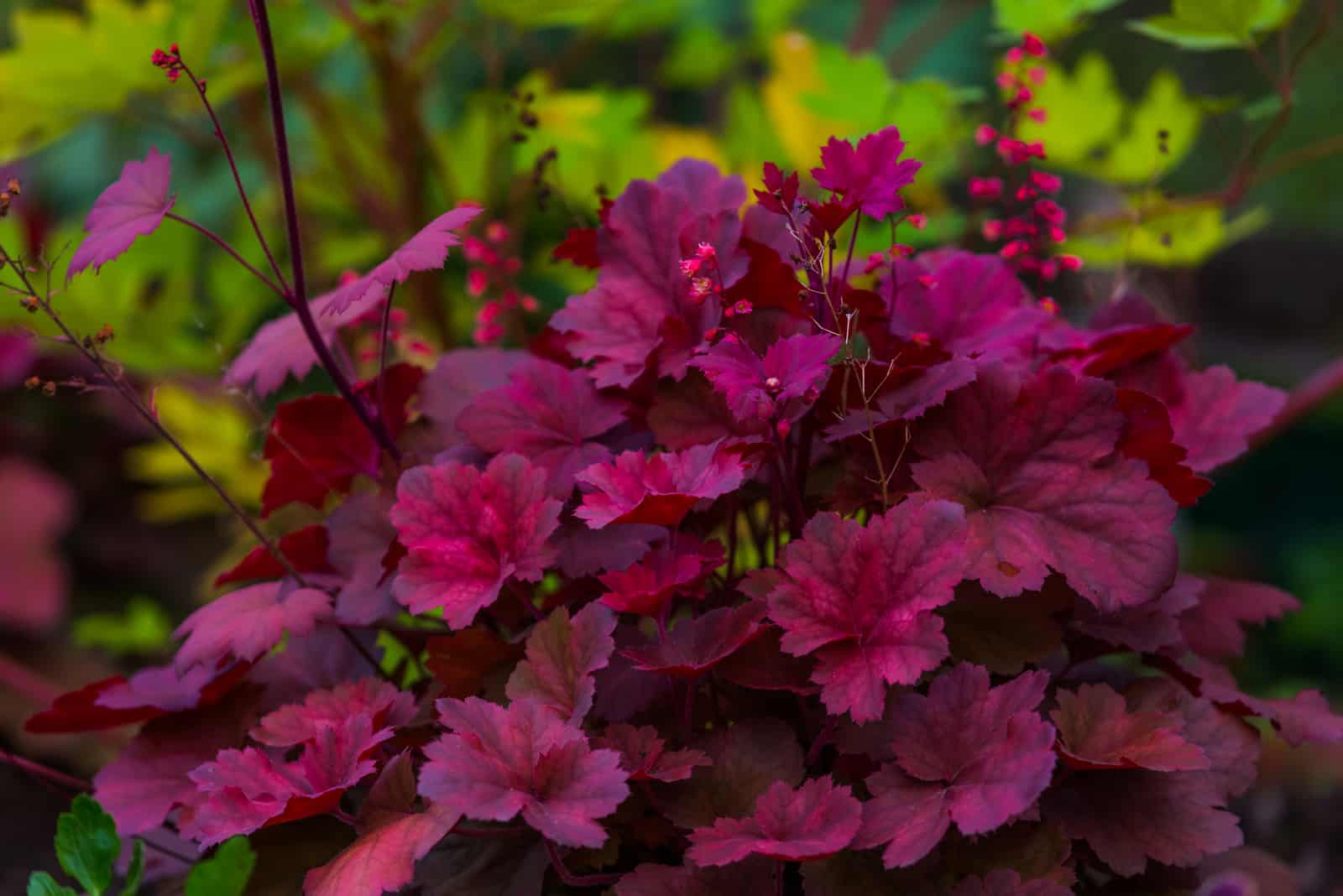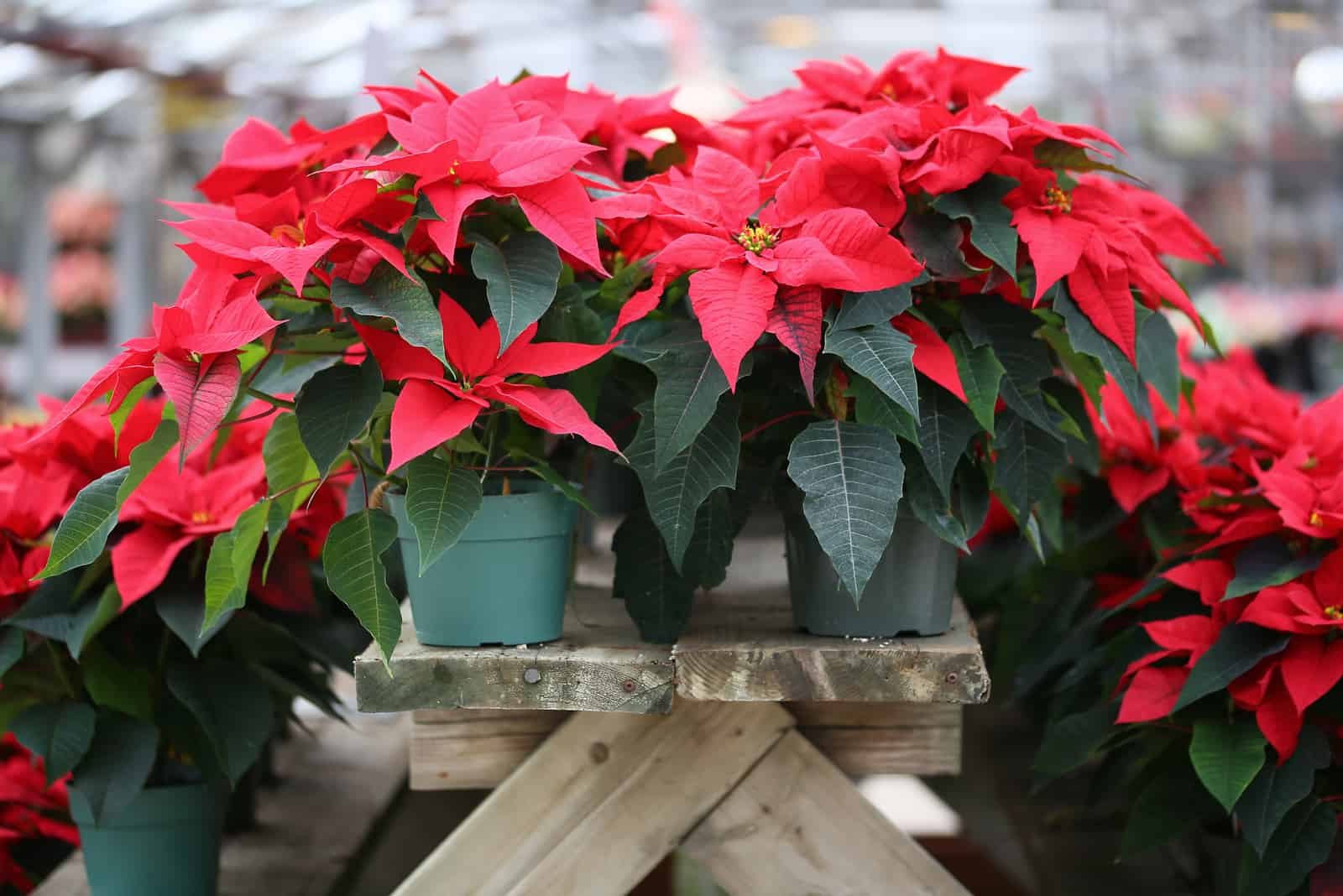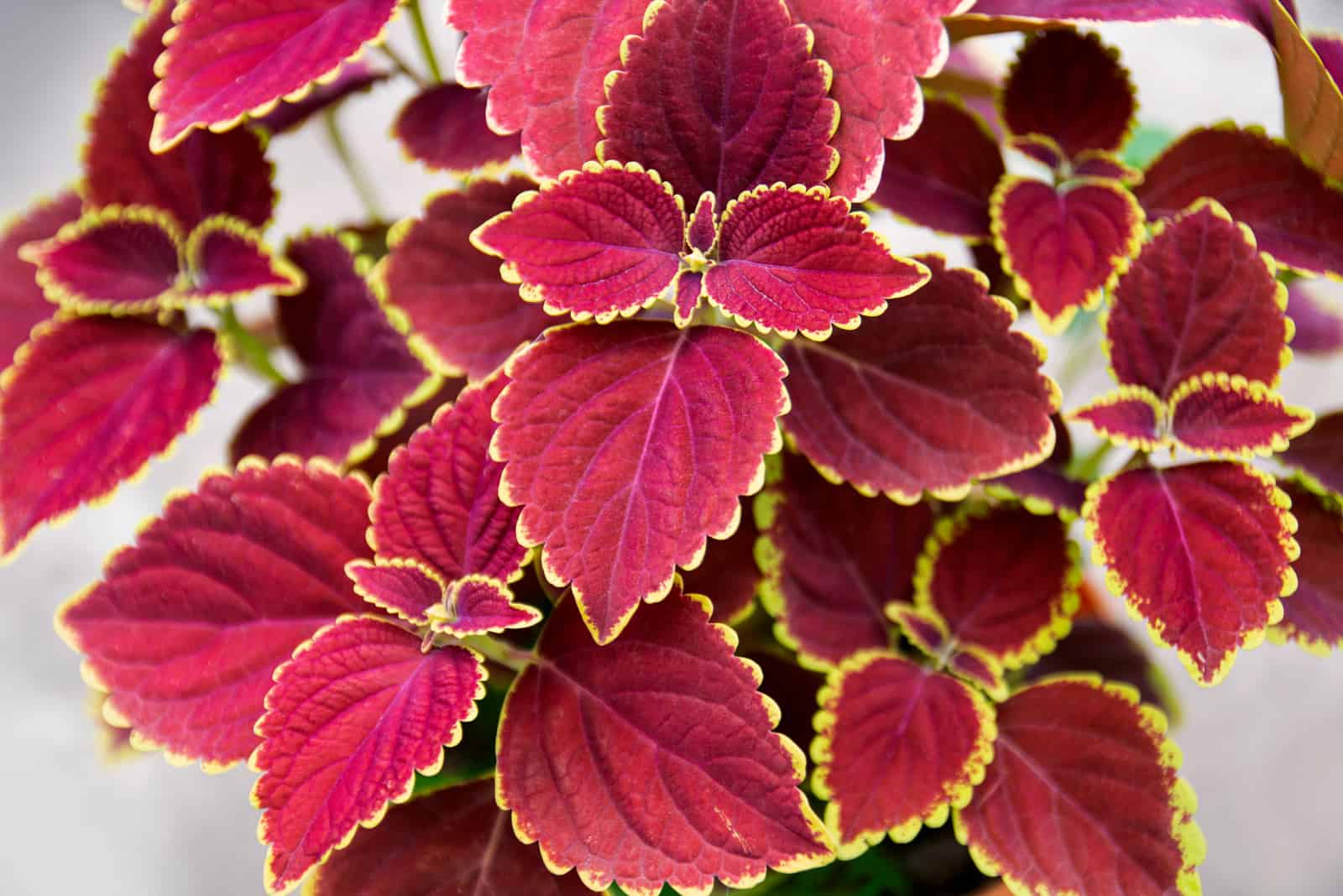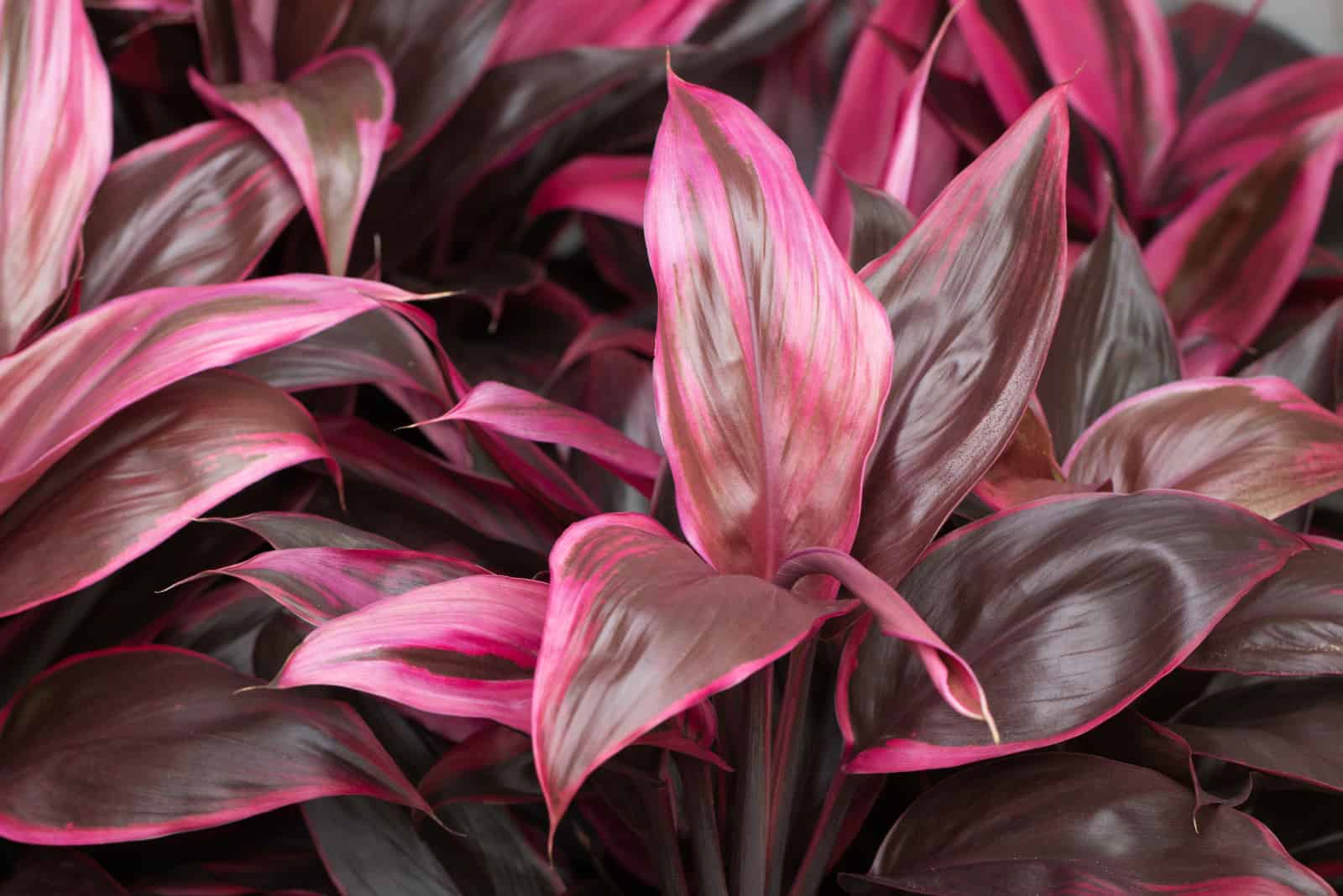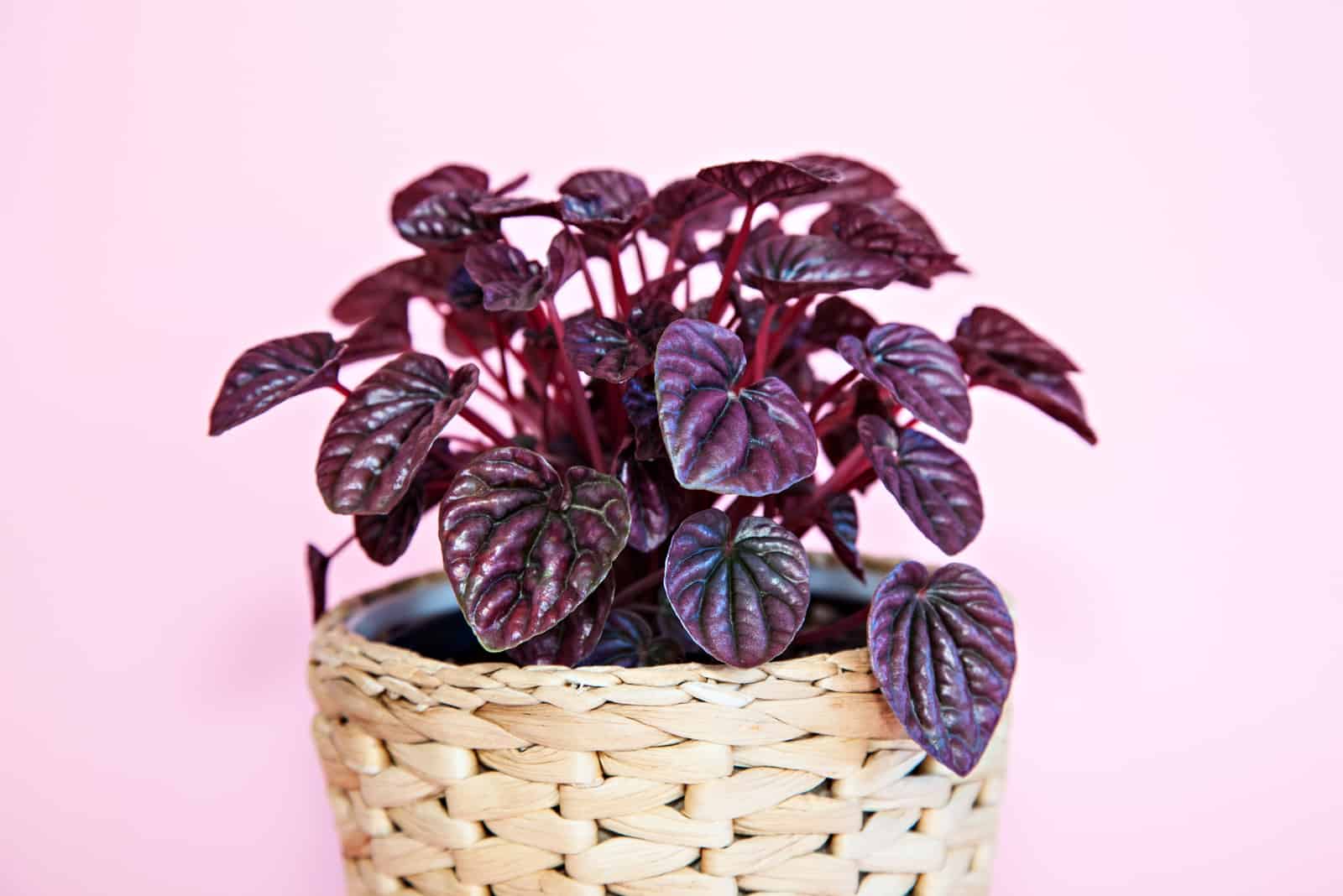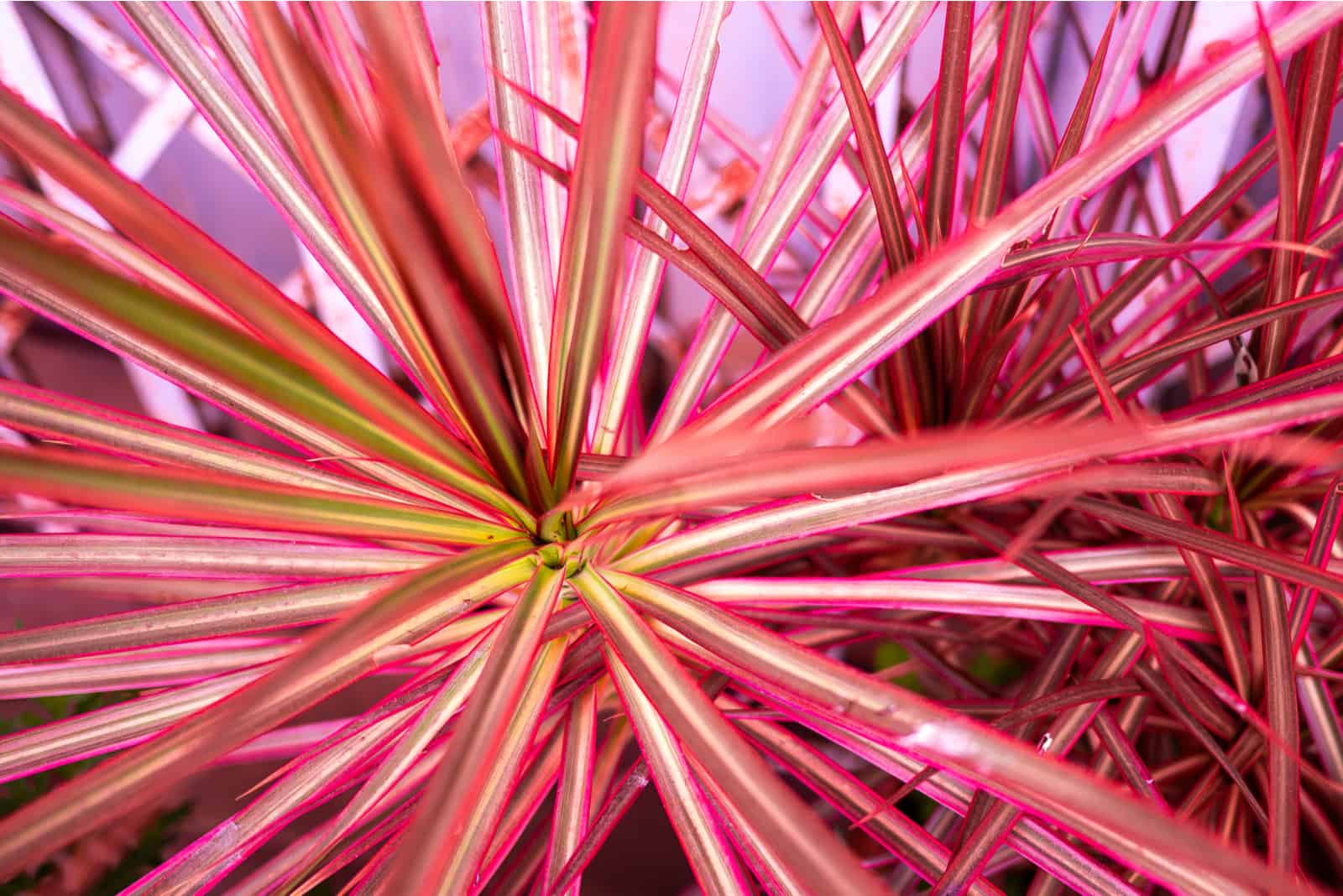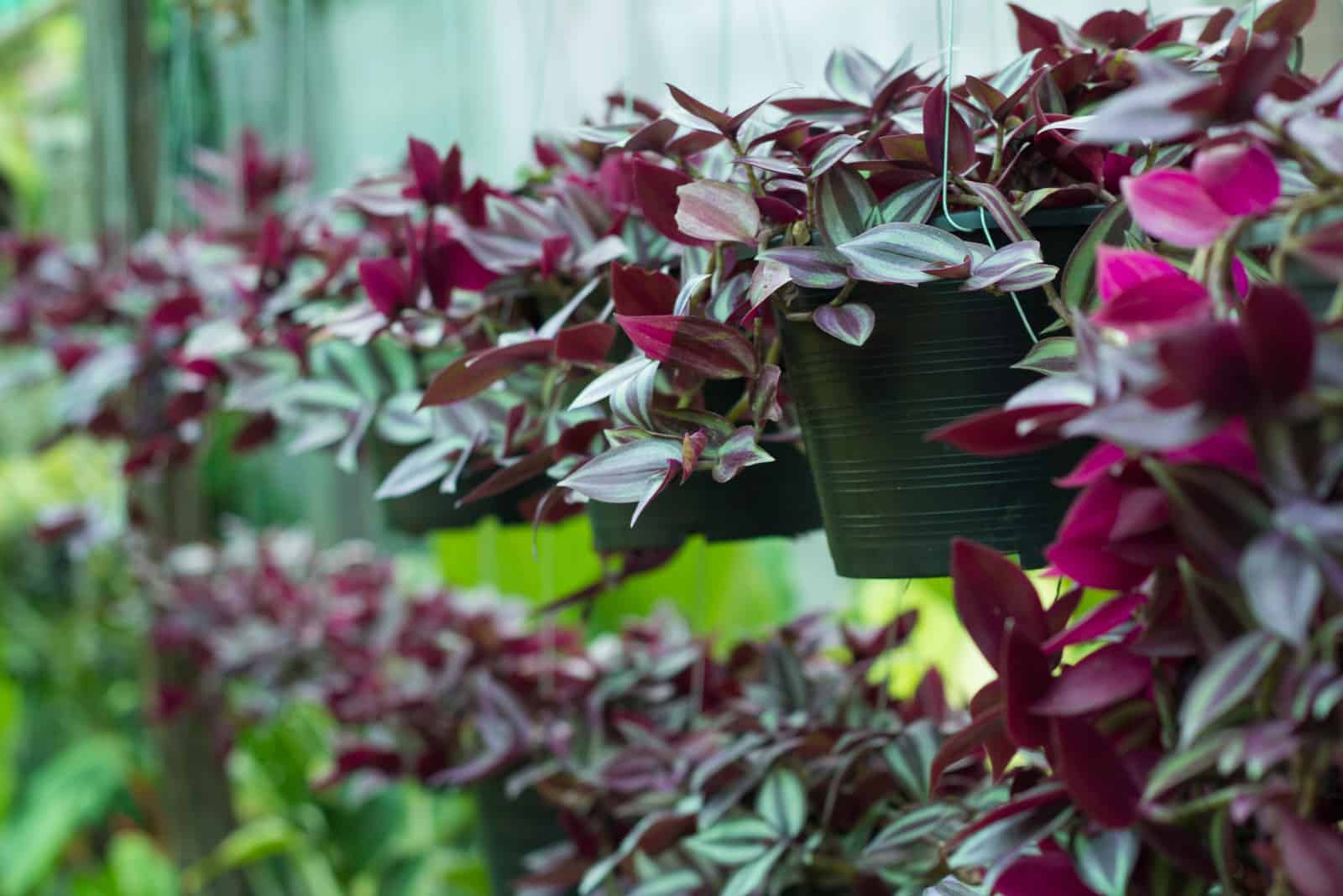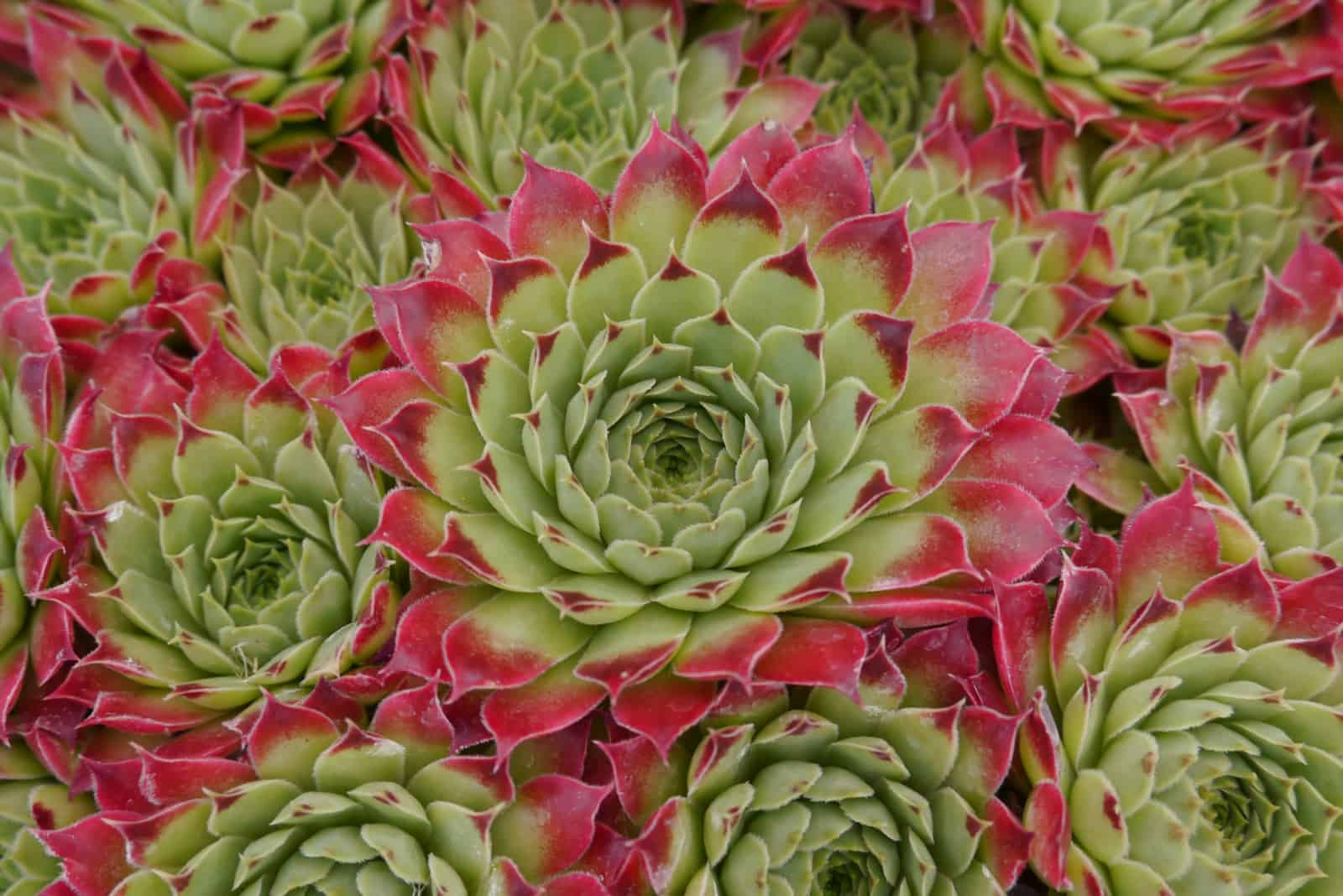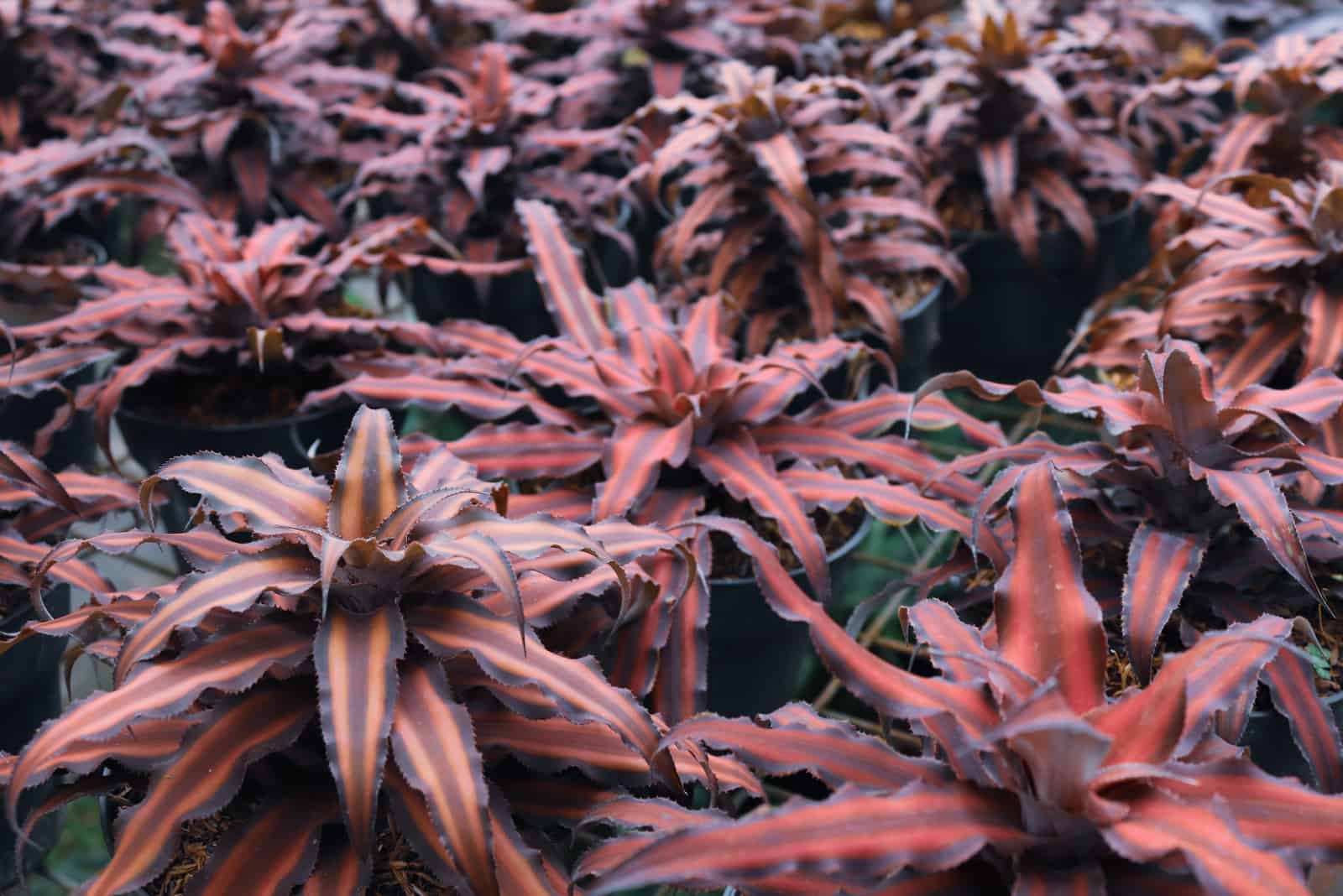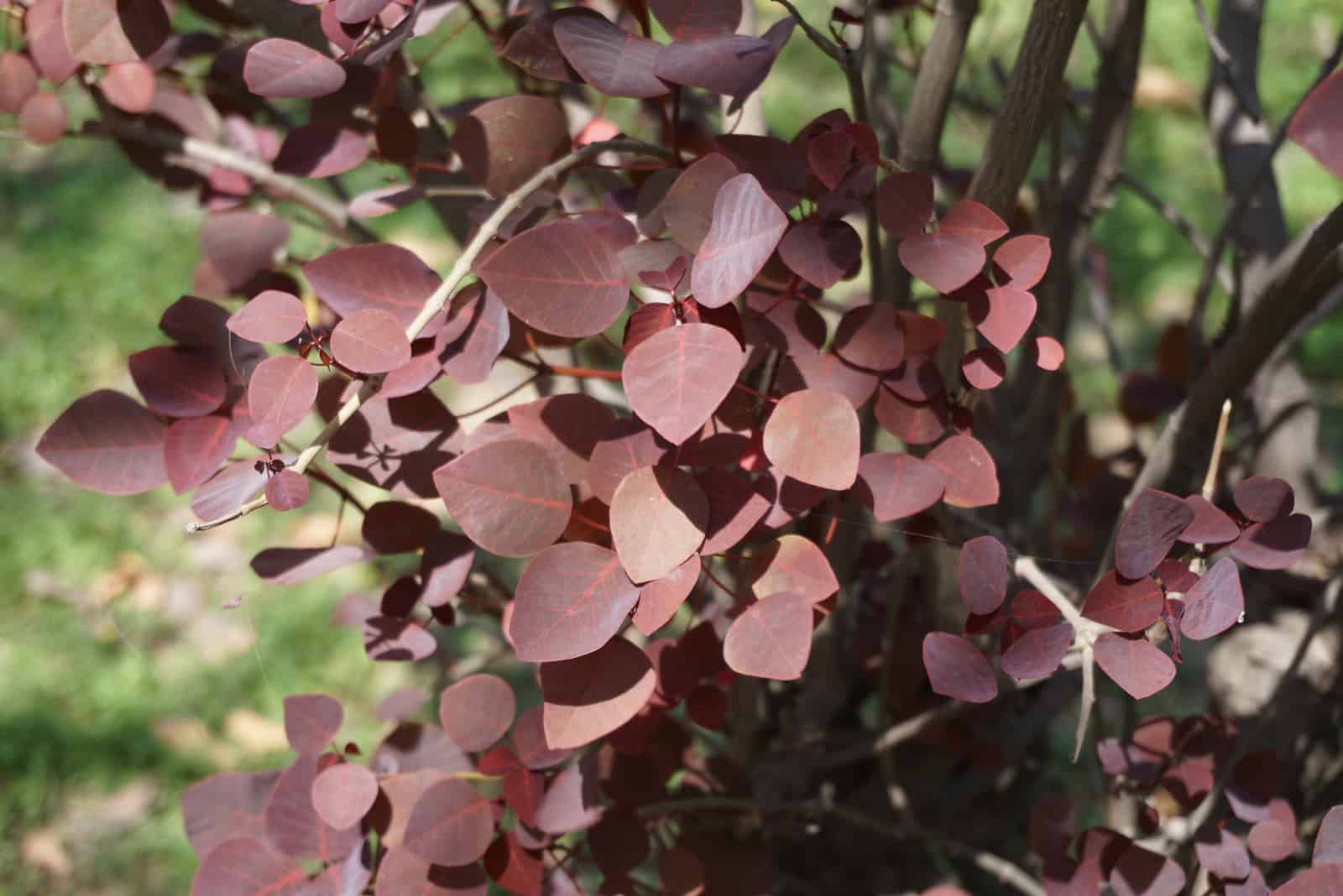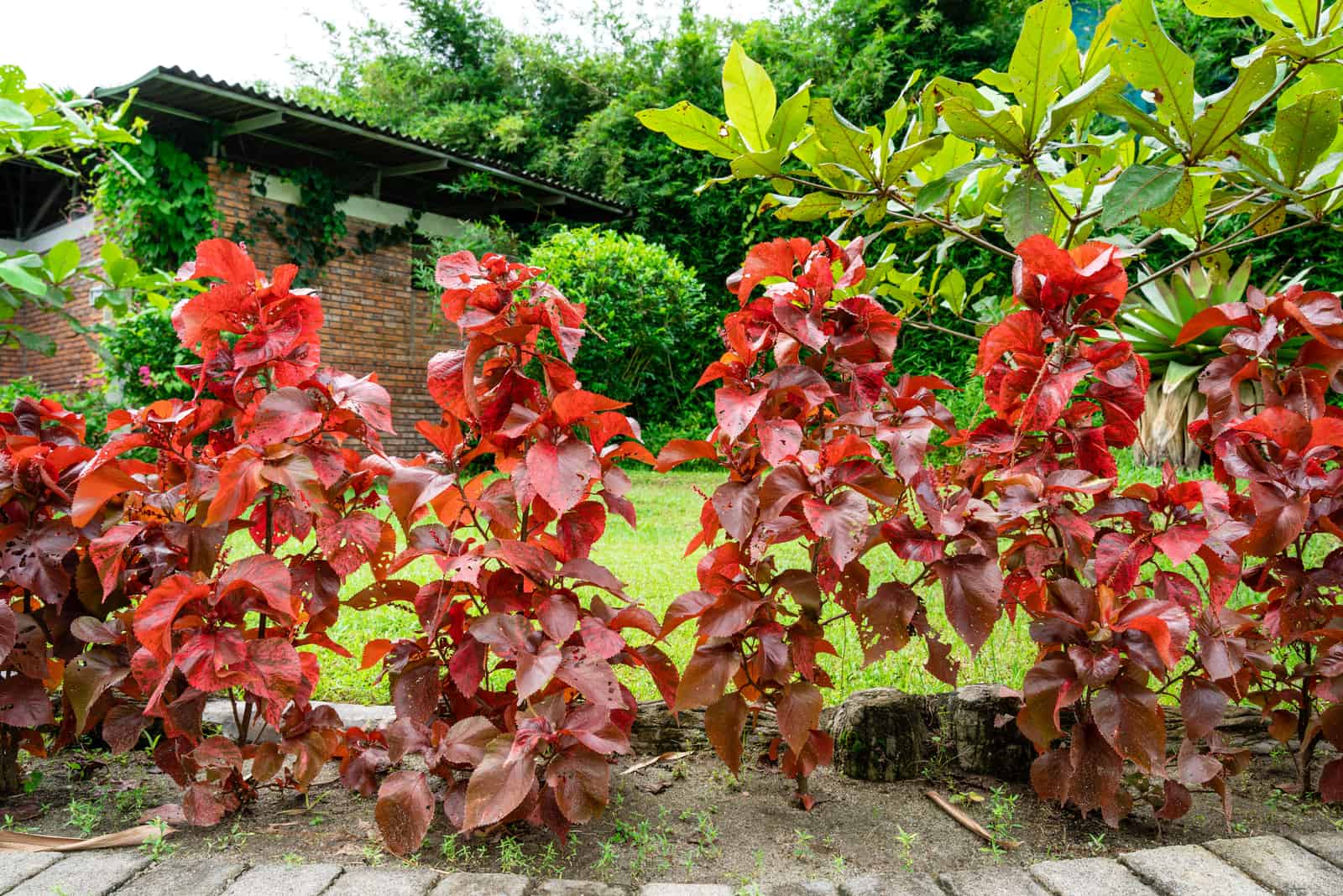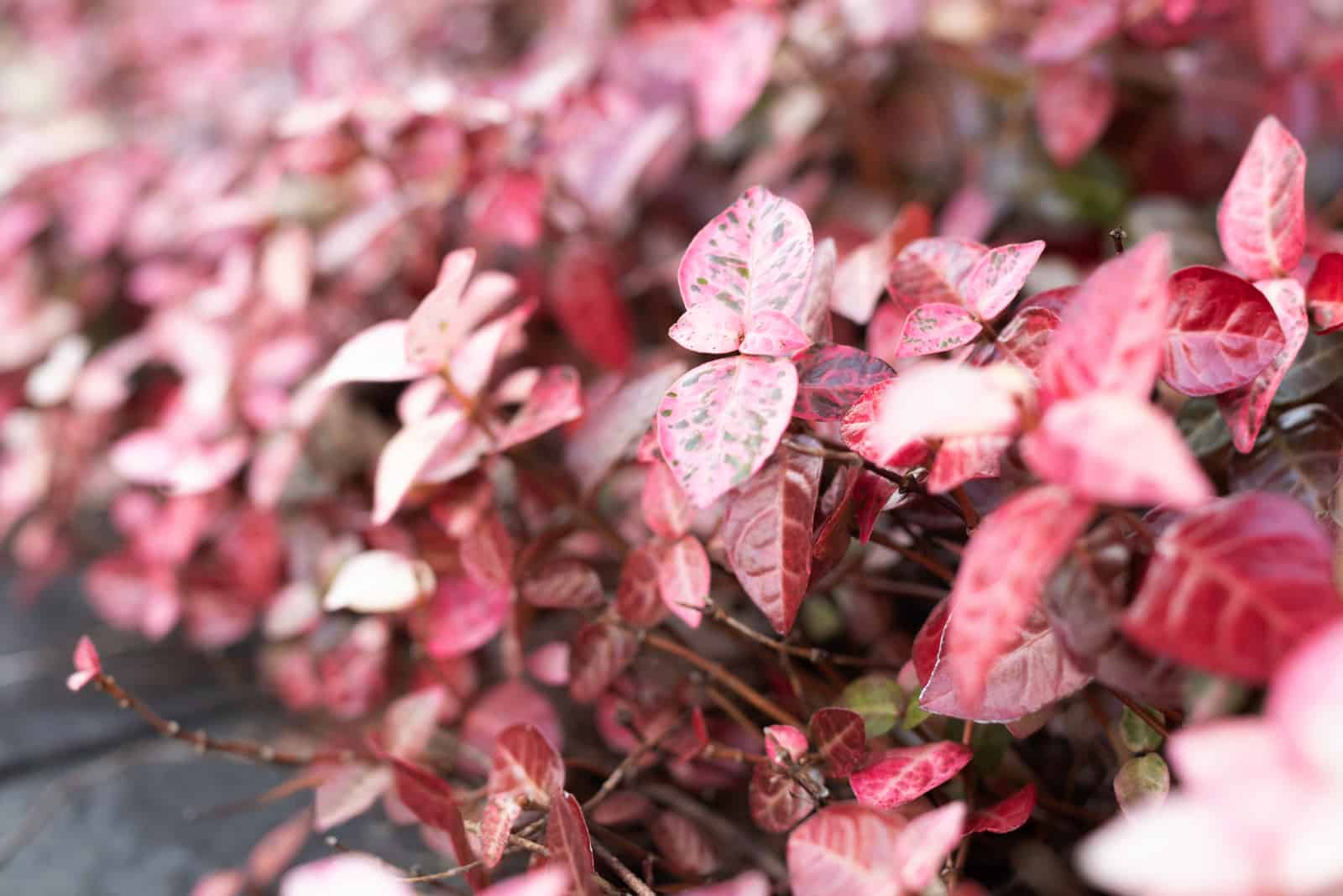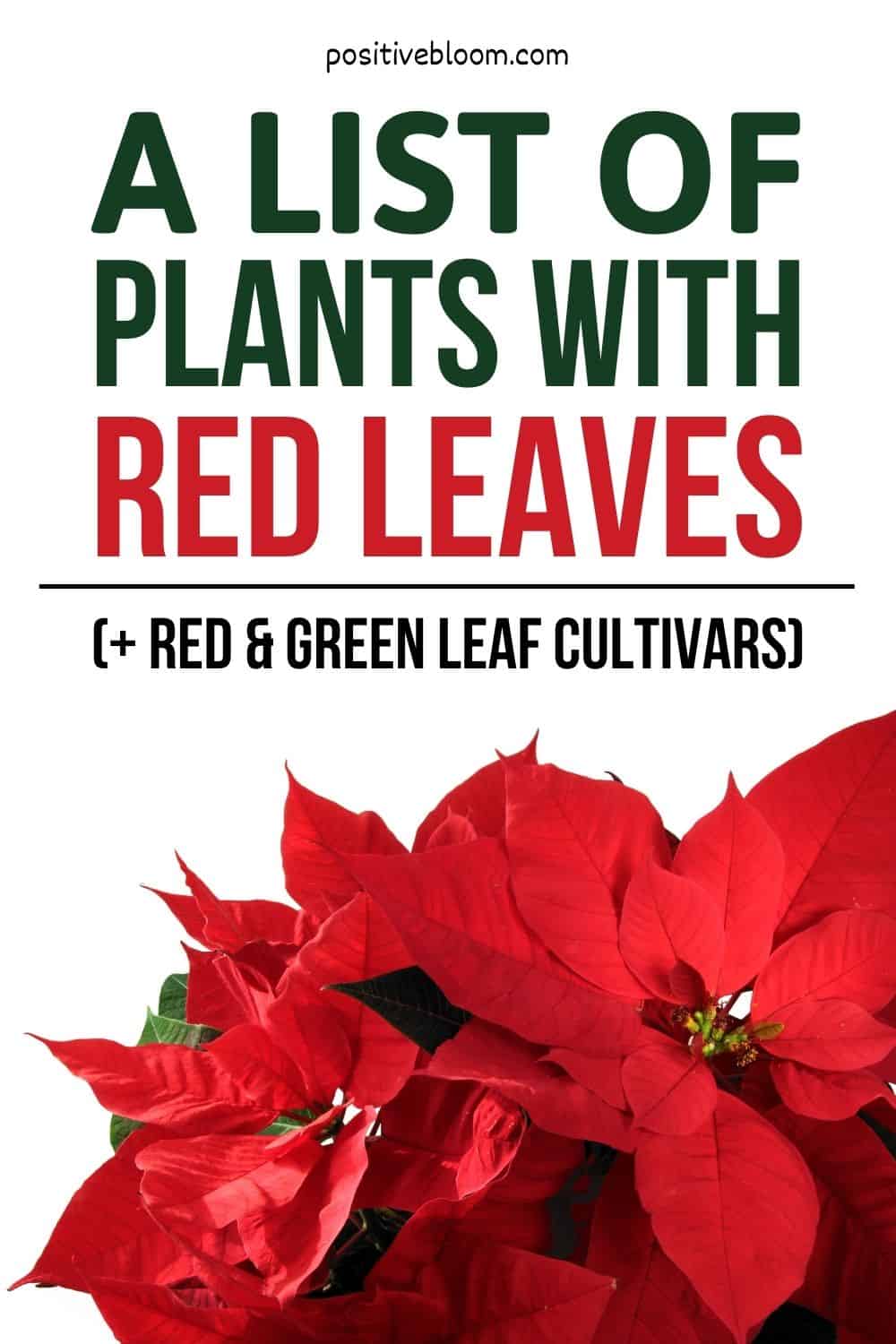I have to admit that I’m not a big fan of red color; or better yet, I wasn’t.
Interestingly, there are many stunning plants with red leaves. The leaves come in different shades of red – deep maroon, bright crimson, light coral, burgundy, magenta, and carmine.
Each red leaf houseplant will make a great addition to your home decor.
The great thing is that you get to choose the shade of red on the leaves and the plant’s size or shape.
The red color is generally associated with passion, romance, and love. Many red-leaf plants also have a symbolic meaning; some plants bring luck and cheerfulness.
I’m sure that when you finish reading this article, you won’t hesitate to buy at least one red-leaf plant.
Most of the plants are affordable and available on the shelves of many supermarkets. And you can always choose to purchase them online.
Let’s start!
Plants With Red Leaves (All Listed)
Red-leaf plants can be divided into plants with natural red leaves and cultivars or hybrids developed by green and red foliage.
No matter which category the plant belongs to, it deserves to be on this list.
If you want to get yourself some red-leaf plants, you can choose among many sizes or shapes.
Additionally, you can choose the shade of red that best fits your home decor.
You will find a lot of families of plants that have more than one red-leaf plant.
Some families have many red plants. Most of the plants listed below are low-maintenance, so you don’t have to spend days worrying about if the plant needs ‘more’ of something.
I should remind you that if you want to see your red plant thrive and grow as many red leaves as possible, you must provide it with enough sun; this is the most essential feature for the leaves of each plant.
Let’s look at our collection of red foliage plants.
Aglaonema (Chinese Evergreen)
I’m sure you already know that the Aglaonema genus has over 20 species.
What you probably don’t know is that some cultivars of the Aglaonema genus have variegated red and green leaves.
Broad-leafed Chinese evergreen plants are many people’s first choice.
Ensure bright indirect light and well-draining soil so that your Chinese evergreens thrive.
There are three most common Aglaonema cultivars with red leaves.
Aglaonema ‘Red Anjamani’
This Aglanoema red plant has breathtaking bright crimson oval leaves with green edges.
The plant stands out because of its sharp leaf tips and greenish veinings that make a spectacular combination with bright crimson.
The plant is slightly bigger than other Aglaonemas, so if you have a bigger living room, Red Anjamani will make a perfect addition.
Aglaonema ‘Valentine’
A picturesque Valentine Aglaonema has broad and colorful leaves. The raspberry red leaves with dark green freckles and edges make this tropical plant an excellent gift for your valentine.
Aglaonema ‘Siam Aurora’
Siam Aurora’s lanceolate leaves have a green-colored center.
Its green foliage has stunning red veins and dark green edges.
Angel Wings (Caladium)
Caladium plants have by far the most colorful foliage. Angel Wings can be multicolored (a combination of different reds, greyish white, dark green, and deep pink) or bi-colored.
When I think of red Caladiums, Cupid comes to mind, and the heart-shaped foliage of some Angel Wings reminds me of love.
There are four red varieties of tropical Caladiums.
Caladium bicolor ‘Red Flash’
This amazing Caladium bicolor has red-colored central parts. The green leaves have red veins, which resemble blood flow.
Pink freckles on the leaves make an even better impression.
Caladium ‘Bombshell’
This red leaf Bombshell makes a great houseplant. The combination of green-colored margins and red veins makes this plant incredible.
Caladium bicolor ‘Florida Red Ruffles’
Florida Red Ruffles’ lanceolate pinkish-red leaves have green margins.
What is impressive about this variety is that it will keep their pinkish-red leaves even if grown in low light.
Caladium bicolor ‘Florida Sweetheart’
This Caladium is a true sweetheart. Heart-shaped leaves and green margins adorn its delicate appearance.
Additionally, the leaves have intricate patterns with pink veins.
Polka Dot Plants (Hypoestes Phyllostachya)
Polka Dot plants got the nickname freckled-faces plants or splashed plants due to the red spots and pink freckles on the leaves.
Let’s look at the three most common Polka Dot plants cultivars.
‘Confetti Blush’ freckle face plant
The green leaves of the Confetti Blush have tiny red spots which resemble freckles.
‘Red Splash Select’
The egg-shaped leaves of Red Splash Select have tiny green spots on the central part of the red veins.
Polka Dot ‘Carmina’
Carmina has bright green leaves with splashes of carmine red.
Croton
Many Croton plant varieties have multicolored leaves. The leaves come in orange, yellow, green, or variegated red colors.
These houseplants thrive best in warmer temperatures.
Let’s look at four Croton plants.
Codiaeum variegatum ‘Red Secretary’
This plant has astonishing red and green leaves that are oblong-shaped and wavy-edged.
Codiaeum variegatum ‘Nervia’
If you prefer bright red color, this Croton cultivar will impress you. The plant has colorful red leaves that blend well with yellow or orange colors.
Codiaeum variegatum ‘Bush on Fire’
Bush On Fire croton has dark red lanceolate leaves combined with yellow, green, and orange.
Codiaeum variegatum ‘Mammy Red’
This cultivar has curled leaves of bright red, yellow, orange, and green color.
Mammy Red will make a great indoor plant due to its upright growth and eye-catching appearance.
Nerve Plants
What is fantastic about Nerve plants is their size; they are relatively small and will fit in the smallest living rooms. You can also easily propagate Nerve plants, even if you are a beginner.
Apart from size, Fittonias have a stunning appearance. The egg-shaped leaves have intricate patterns (white, green, or pink) and red veins.
‘Red Anne’ nerve plant
This common indoor plant has pinkish-red veinings.
‘Black Star’ nerve plant
The Black Star plant has dark green leaves and magenta patterns.
‘Juanita’ nerve plant
This Fittonia plant has large light red leaves reminiscent of nerves.
‘Red Star’ nerve plant
The leaves are deep-pink red and have red veinings.
Anthuriums
What I really like about Anthuriums is their outstanding flowers. They consist of beautiful red leaves (heart-shaped bracts) and pastel-yellow flowers (spadix) with green pigment.
Anthurium plants best thrive in indirect light.
‘Flamingo Lily’ (Anthurium andraeanum)
Flamingo Lily is a breathtaking plant. Its heart-shaped waxy leaf and yellowish spadix combine with the red spathes’ bumpy surface.
Pigtail Plant (Anthurium scherzerianum)
The Pigtail Plant, also known as Flamingo Flower, is an exotic Anthurium. It has curled orange-red leaves, which are reminiscent of pigtails.
Heuchera (Coral Bells)
If you are looking for low-maintenance red plants, you should choose Coral Bells. They will thrive if exposed to full sun and in places with partial shade.
Heucheras love moist soil with porous structures.
These plants are also known as Forever Red plants. Therefore, if you really like the red color, get yourself one of the following Heucheras:
Heuchera ‘Blondie’
This miniature perennial has dark red leaves and stems. Blondie produces a significant number of yellowish flowers throughout the entire growing season.
Heuchera ‘Fire Alarm’
This Coral Bells plant has bright red leaves at the beginning of the growing season (early spring). By the end of the growing season, the leaves turn dark red.
Heuchera ‘Cherry Cola’
Cherry Cola has rich rust-red leaves, and it is eye-catching in bloom.
Poinsettia (Euphorbia pulcherrima)
If you want a plant that produces scarlet leaves during winter, you should get yourself a Poinsettia plant.
A combination of scarlet-red and green leaves gives Poinsettia a fascinating appearance. Not every Poinsettia has red leaves; there are some cultivars whose leaves come in white, light green, orange, or yellow.
Euphorbia pulcherrima’s leaves are called red bracts or modified leaves.
During winter, the plant produces red leaves; it is often called the Flower Of Christmas. Therefore, it can be the focal point of your Christmas decorations.
Many discard the plant after flowering, not knowing that it can be saved if kept away from sunlight.
Coleus
The tropical evergreen plants from the Coleus genus are low-maintenance plants, often seen in households.
Coleus plants have multicolored leaves; for example, some cultivars have red and green, orange, magenta, or light green leaves with burgundy margins.
Let’s look at the four most common red-leaf cultivars from the Coleus genus.
Solenostemon Redhead (Coleus ‘Redhead’)
This plant has red leaves that grow if exposed to full sun but also if there is partial shade.
A bushy Solenostemon Redhead produces a significant number of red leaves; red and green leaves are also visible in the middle.
Solenostemon ‘Pineapple’ (Coleus ‘Pineapple’)
This Coleus plant has bright green leaves with thin saw-like margins. This plant enjoys direct sunlight and partial shade.
Coleus ‘Kong Red’
Kong Red has large green leaves with maroon centers. Ensure partial or full shade to protect the leaves and help the plant thrive.
Coleus ‘Wizard Scarlet’
The leaves of Wizard Scarlet come in scarlet and have vibrant green margins.
This plant requires indirect sunlight. Ensuring this condition will avoid various complications, and the plant will grow healthy.
Ti Plant (Cordyline fruticosa)
You can find Ti Plant in many homes, and its cultivars come in many shades of red color.
The shade of red lanceolate leaves will depend on sunlight exposure. The tall leaves are rosette-shaped and have red crowns. Amazingly, this plant’s new growth appears in different shades of pink.
You can find Ti Plant cultivars under the Hawaiian Good Luck Plant or Cabbage Tree.
Cordyline fruticosa ‘Firebrand’
This plant has scarlet and green spiky leaves.
Rubra Cordyline (Cordyline fruticosa ‘Rubra’)
This Cordyline fruticosa cultivar has large scarlet leaves with deep green tinges.
Cordyline fruticosa ‘Lilinoe’
The pinkish-red leaf color of Lilinoe makes the plant spectacular, along with the fact that it will even grow in full sun.
Peperomia (Radiator Plants)
If you look at one Peperomia that is considered to have red leaves, you may be confused. But if you take a closer look, you will notice that these ornamental plants have leaves with red undersides and red stems.
Let’s look at some Radiator Plants with red and green leaves.
‘Red Log’ Peperomia (Peperomia verticillata)
This colorful houseplant has dark green leaves with red undersides.
‘Jelly’ radiator plant (Peperomia clusiifolia)
This plant is also known as Peperomia Tricolor due to its red, green, and cream foliage.
Peperomia rubella
Peperomia rubella has dark green leaves with red stems and red undersides.
‘Emerald Ripple Red’ (Peperomia caperata)
Hearth-shaped green and burgundy leaves make the Emerald Ripple red plant outstanding.
Dracaena Marginata ‘Tricolor’ (Madagascar Dragon Tree)
The leaves of the Madagascar Dragon tree come in three colors: light green, light red, and yellow.
The plant has thin green rosette-shaped leaves with bright red margins.
The leaves grow upwards on a woody stem, giving the plant a spiky crown.
Dracaena Marginata ‘Tricolor’ thrives best in bright indirect light, and it can grow up to 6 ft.
This plant will make a great addition to your home, and it is not only attractive but also an air-filtering plant.
Tradescantia (Wandering Jew)
There are over 70 Tradescantia plants, also known as flowering inch plants, spiderwort, oyster plants, and spider-lily.
Wandering Jew is mainly planted in a hanging basket when grown as a houseplant due to its trailing feature.
The plants from the Tradescantia genus are burgundy or have red leaves and red stripes.
Let’s look at the four most common Wandering Jews.
Wandering Jew ‘Red’ (Tradescantia zebrina ‘Red’)
This oyster plant has red stripes on the leaves and burgundy undersides.
Moses-in-the-Cradle (Tradescantia spathacea)
This plant has pointed burgundy leaves and is often called Boat Lily.
Tradescantia ‘Cool Leaf’
This spider-lily plant has large dark red leaves that grow on a woody stem.
Inch Plant ‘Quadricolor’ (Tradescantia zebrina ‘Quadricolor’)
Tradescantia Inch Plant ‘Quadricolor’ has green and burgundy stripes on the upper sides and dark red stripes on the undersides of its leaves.
Succulents With Red Leaves
A significant number of succulents have red leaves. Some succulents have dark green leaves with red blushing when exposed to direct sunlight.
The shades of red you can find on different succulents are burgundy, scarlet, cherry, or rosy red.
Here’s a video on how to make your succulent red:
I would like to share seven succulent plants with red leaves with you.
Sempervivum calcareum
Some cultivars of rosette-shaped Sempervivum plants have cerulean leaves with red tips. Other cultivars may have fleshy, crimson-pointed leaves.
Crassula capitella ‘Campfire’
Young Campfire plants have green leaves, and when matured, the leaves turn red or orange. Crassula capitella varieties grow best in bright light.
Moon Cactus (Gymnocalycium Mihanovichii)
This breathtaking cactus has a round bright red, pink, yellow, or orange top.
Sedum rubrotinctum ‘Aurora’
This Sedum succulent has round red and green leaves.
When exposed to direct sunlight, Aurora develops bright red leaves.
On the other hand, the plant will develop bi-color leaves if grown in low light.
Crassula capitella ‘Red Pagoda’
Another Crassula variety, the spectacular Red Pagoda, has triangle-shaped red and green leaves that form a tower.
The rosette pattern of the leaves resembles a pagoda tower.
To accentuate its beauty, plant Red Pagoda in a hanging basket.
Red Aloe
This plant, otherwise known as Aloe cameronii, is a succulent evergreen with brownish-red or green leaves. This plant can tolerate extended periods without water. If you overwater it, you will notice the red leaves turn green.
Echeveria Agavoides ‘Romeo Rubin’
This low-maintenance succulent plant has rosette-shaped burgundy leaves. Romeo Rubin’s rosette is prone to root rot, so make sure you don’t overwater the plant.
Romeo Rubin has incredible white flowers that contrast with its burgundy leaves.
Rex Begonias With Red Leaves
The Begonia genus has thousands of species, and there are many with shades of red-colored leaves.
Eye-catching Red-leaf Begonias belong to the Rex Begonia cultorum.
‘Red Kiss’ Begonia (Rex Begonia ‘Red Kiss’)
Red-colored ‘Red Kiss’ leaves have dark purple centers, which give the plant a stunning appearance.
Begonia ‘Red Bull’ (Rex Begonia ‘Red Bull’)
The Red Bull Begonia cultivar is an excellent choice for smaller living rooms. It has red and shiny leaves with dark curly margins.
Begonia ‘Revelation Maroon’
This is a Begonia hybrid, and because of its trailing features, it is mainly grown in hanging baskets. It has dark red and shiny leaves with emerald green veins.
‘Omaha Beefsteak’ Begonia
Omaha Beefsteak has bright, raspberry red-painted leaves with black spots in the center.
Begonia ‘Stained Glass’ (Rex Begonia ‘Stained Glass’)
Red-colored leaves with dark veins and rosy-red undersides give the plant a spectacular appearance.
Bromeliad Plants (Bromeliaceae)
The Bromeliaceae family contains 75 genera, and many species are known for their red flowers. Interestingly, the red flowers of most of those species are not ‘flowers’; they are bracts or modified leaves.
As there are so many species, it’s no surprise that the leaves can come in many shades of red and yellow, green, or in combination with orange.
Although it may seem complicated to care for Bromeliads, this is probably a myth. These plants can even thrive in low light, so they are an excellent choice for bathrooms.
Cryptanthus
The plants of the Cryptyanthus genus are commonly known as Earth Stars. These plants have pointed red, dark green, and pinkish leaves. Ensure bright indirect light or partial shade, and your Crypyanthus plant will bloom throughout the year.
Guzmania Bromeliads
Guzmanias are Bromeliads’ hybrids; plants from the Guzmania genus are the most available and affordable compared to other Bromeliads.
The Guzmania plant has bright red bracts and is commonly known as Scarlet Star.
Guzmanias make perfect indoor plants due to their low maintenance, and the plant stays in bloom for up to 4 months.
Red Air Plant
This Bromeliad plant doesn’t need to grow in soil, and its leaves absorb water and nutrients from the air.
Red Air Plants come in dark or light green and red. The colors can also be combined.
If the plant receives enough water and light, it will turn red. This is also a sign that the Red Air Plant is ready to bloom.
Tropical Smoke Bush (Euphorbia cotinifolia)
Can you believe that this plant is only 3–4 inches tall? You can also find this plant under the name Smoke Bush ‘Velveteeny.’ This is one of my favorite miniature plants; it fits everywhere and is low-maintenance. Even though the term bush is in its name, the Smoke Bush plant doesn’t need pruning.
What makes Velveteeny stunning is its feature to transform from a purple to deep red color, which happens in the early fall.
The plant loses its foliage in mid-December. Therefore, you can enjoy its stunning appearance almost the entire year.
Additionally, this plant is easily propagated by softwood cuttings in the summer.
Copperleaf
Many plant growers recommend Copper plants as substitutes for Crotons. In my opinion, Copper plants are equally beautiful and should not be an alternative but rather the first choice.
Acalypha wilkesaina, also known as Jacob’s coat and Match-Me-If-You-Can, is a Copperleaf mainly used as an ornamental plant. Its unique dark red foliage has inspired agricultural engineers to develop over 100 varieties.
What I found impressive about Jacob’s coat is that it is not just an ornamental plant, but it is often used for different medicinal purposes; it is believed to cure flu, skin lesions, and gastrointestinal disorders. Therefore, Copperleaf’s health benefits are one of the main reasons to grow it.
Asian Jasmine (Trachelospermum asiaticum)
I’m in love with jasmine in general, and this variety makes the plant stand out even further.
Apart from the botanical name (Trachelospermum asiaticum) and the most common name Asian Jasmine, you can find the plant under Japanese Star Jasmine, Dwarf Confederate Jasmine, and Small Leaf Jasmine.
You’ll have to wait until Asian Jasmine develops its leaves, which come not only in red but also in yellow, green, and orange.
In my opinion, it’s worth it.
Wrapping Up
If you couldn’t decide which option to choose from the many plants with red leaves, I’m sure that you will have no doubts after reading this article.
Each plant listed above has a unique appearance, and what is fantastic is that the red leaf on each plant differs in size, shape, or shade of red.
No matter which plant you choose, you’ll enjoy its beauty.
Until next time!
Like this post? Share or pin it for later!

